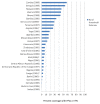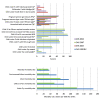Impact of national malaria control scale-up programmes in Africa: magnitude and attribution of effects
- PMID: 20979634
- PMCID: PMC2988827
- DOI: 10.1186/1475-2875-9-299
Impact of national malaria control scale-up programmes in Africa: magnitude and attribution of effects
Abstract
Background: Since 2005, malaria control scale-up has progressed in many African countries. Controlled studies of insecticide-treated mosquito nets (ITNs), indoor residual spraying (IRS), intermittent preventive treatment during pregnancy (IPTp) and malaria case management suggested that when incorporated into national programmes a dramatic health impact, likely more than a 20% decrease in all-cause childhood mortality, was possible. To assess the extent to which national malaria programmes are achieving impact the authors reviewed African country programme data available through 2009.
Methods: National survey data, published literature, and organization or country reports produced during 2000-2009 were reviewed to assess available malaria financing, intervention delivery, household or target population coverage, and reported health benefits including infection, illness, severe anaemia, and death.
Results: By the end of 2009, reports were available for ITN household ownership (n = 34) and IPTp use (n = 27) in malaria-endemic countries in Africa, with at least two estimates (pre-2005 and post-2005 intervals). Information linking IRS and case management coverage to impact were more limited. There was generally at least a three-fold increase in household ITN ownership across these countries between pre-2005 (median of 2.4% of households with at least one ITN) and post-2005 (median of 32.5% of households with at least one ITN). Ten countries had temporal data to assess programme impact, and all reported progress on at least one impact indicator (typically on mortality); in under-five year mortality rates most observed a decline of more than 20%. The causal relationship between malaria programme scale-up and reduced child illness and mortality rates is supported by biologic plausibility including mortality declines consistent with experience from intervention efficacy trials, consistency of findings across multiple countries and different epidemiologic settings, and temporal congruity where morbidity and mortality declines have been documented in the 18 to 36 months following intervention scale-up.
Conclusions: Several factors potentially have contributed to recent health improvement in African countries, but there is substantial evidence that achieving high malaria control intervention coverage, especially with ITNs and targeted IRS, has been the leading contributor to reduced child mortality. The documented impact provides the evidence required to support a global commitment to the expansion and long-term investment in malaria control to sustain and increase the health impact that malaria control is producing in Africa.
Figures










References
-
- Roll Back Malaria Partnership. Global Malaria Action Plan. Geneva. 2008.
-
- Lengeler C. Insecticide-treated bed nets for preventing malaria. The Cochrane Library. 2007;3 - PubMed
-
- Hawley WA, Phillips-Howard PA, ter Kuile F, Terlouw DJ, Vulule JM, Ombok M, Nahlen BL, Gimnig JE, Kariuki SK, Kolczak MS, Hightower AW. Community-wide effects of permethrin-treated bednets on child mortality and malaria morbidity in Western Kenya. Am J Trop Med Hyg. 2003;68:121–127. - PubMed
-
- ter Kuile FO, Terlouw DJ, Phillips-Howard PA, Hawley WA, Friedman JF, Kolczak MS, Kariuki SK, Shi YP, Kwena AM, Vulule JM, Nahlen BL. Impact of permethrin-treated bed nets on malaria and all-cause morbidity in young children in an area of intense perennial malaria transmission in western Kenya: cross-sectional survey. Am J Trop Med Hyg. 2003;68:100–107. - PubMed
MeSH terms
LinkOut - more resources
Full Text Sources
Other Literature Sources
Medical

